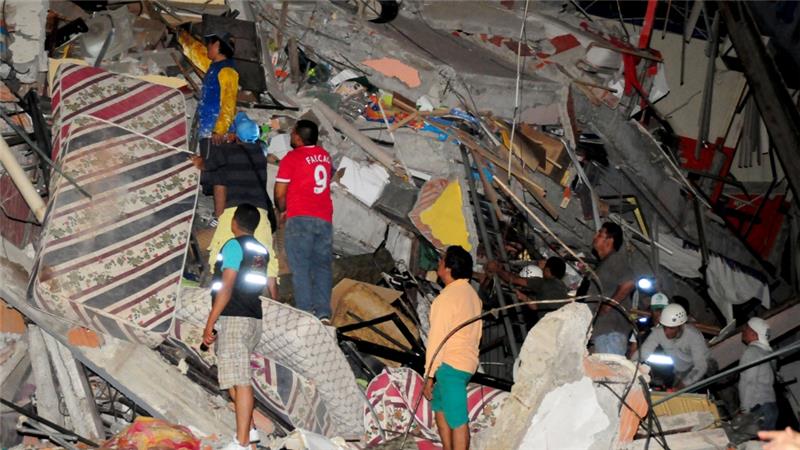The death toll from Ecuador’s biggest earthquake in decades has risen to at least 233 as rescue teams raced to find survivors in shattered coastal towns.
The powerful 7.8-magnitude quake struck off the Pacific coast on Saturday and was felt around the country, flattening buildings and buckling roads in several western towns.
President Rafael Correa, who was rushing home from a trip to Italy, said the confirmed number of fatalities increased on Sunday to 233 – officials had previously put the toll at 77 dead and nearly 600 injured.
“The immediate priority is to rescue people in the rubble,” Correa said via Twitter.
More than 1,500 people were injured, authorities said.
The US Geological Survey said the shallow quake was centred 27km south-southeast of Muisne, a sparsely populated area of fishing ports that’s popular with tourists.
Coastal areas nearest the quake were worst affected, especially Pedernales, a tourist spot with beaches and palm trees. Information was scant from there due to poor communications and transport chaos.
“There are people trapped in various places and we are starting rescue operations,” Vice President Jorge Glas said on Sunday morning before boarding a plane to the area.
“There are villages totally devastated,” Pedernales’ mayor Gabriel Alcivar told local radio, adding that “dozens and dozens” had died in the rustic zone.
“What happened here in is catastrophic.”
A state of emergency was declared in six provinces.
In Guayaquil, the country’s most populous city, rubble lay in the streets and a bridge fell on top of a car.
“It was terrifying, we were all scared and we’re still out in the streets because we’re worried about aftershocks,” Fernando Garcia, a Guayaquil security guard, told Reuters news agency.
Photos from the coastal city of Manta, where the airport was closed after the control tower collapsed, showed Red Cross workers arriving, police hunting through debris, a smashed sculpture and badly-damaged buildings.
Ramon Solorzano, a 46-year-old local car parts merchant, said he was leaving with his family.
“Most people are out in the streets with backpacks on, heading for higher ground,” Solorzano told Reuters, speaking in a trembling voice on a WhatsApp phone call. “The streets are cracked. The power is out and phones are down.”
Residents streamed into the streets of the capital Quito, hundreds of miles away, and other towns across the nation.
About 13,500 security force personnel were mobilized to keep order around the country, and $600m in credit from multilateral lenders was immediately activated for the emergency, the government said.
The country’s Geophysics Institute in a bulletin said the quake struck at around 8pm (01:00 GMT) at a depth of 20km.
Among those killed was the driver of a car crushed by an overpass that buckled.
On social media residents shared photos of homes collapsed, the roof of a shopping centre coming apart and supermarket shelves shaking violently.
The Pacific Tsunami Warning Center said hazardous tsunami waves are possible for some coasts but the government has not issued a tsunami alert.
Hydroelectric dams and oil pipelines in the OPEC-member nation were shut down as a precautionary measure.
Also on Sunday, a magnitude 6.1 earthquake struck southeast of the Pacific island nation of Tonga.
Earlier in the week, two deadly earthquakes hit the southernmost of Japan’s four main islands.
A magnitude-6.5 earthquake struck Thursday near Kumamoto, followed by a magnitude-7.3 earthquake just 28 hours later.
The quakes have killed 41 people and injured about 1,500, flattening houses and triggering major landslides.
[Source: Al-Jazeera]





 WhatsApp us
WhatsApp us 

